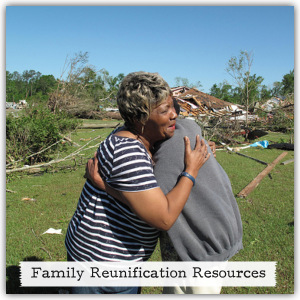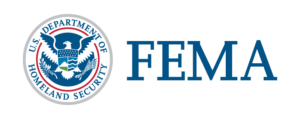Reunification Support
Reunification support provides mechanisms to help displaced disaster survivors reestablish contact with family and friends. This plan is critical for the personal reconnection of disaster survivors and their support systems who may have limited means to communicate and reunify. Communities can help citizens who are separated from family and friends, by developing and implementing a comprehensive and integrated reunification plan.
Reunification Plans should include:
- Access to information about resources to support immediate reunification efforts
- Awareness of mechanisms, e.g. social media as a means of communication
- Access to resources that support individual ability to reconnect on their own. In areas where survivors are located:
- Charging stations
- Access to internet
- Ways of communicating
- Physical reunification, especially for missing children, adults, pets and service animals

 EXERCISE STARTER KIT FOR REUNIFICATION SUPPORT (January 2024)
EXERCISE STARTER KIT FOR REUNIFICATION SUPPORT (January 2024)
The Federal Emergency Management Agency’s (FEMA’s) National Exercise Division (NED) has Exercise Starter Kits to support exercise practitioners and emergency managers at all levels of government, the private sector, and nonprofit organizations as they plan, conduct, and evaluate their exercises.
The Reunification Exercise Starter Kit (ESK) contains a sample exercise facilitator and evaluator guide, sample conduct slides, a sample situation manual and a customizable placemat:
- Sample conduct slides for Reunification
- Sample Facilitator/Evaluator Guide for Reunification
- Sample Situation Manual for Reunification
- Customizable Placement for Reunification
Other Exercise Starter Kits are available in the Emergency Management Toolkit section of FEMA’s Preparedness Toolkit. A recorded webinar will be available on the Preparedness Toolkit HSEEP Webinars page starting Feb. 1. If you have any questions, please email NEP@fema.dhs.gov.
MULTI-AGENCY REUNIFICATION SERVICES PLAN TEMPLATE (MAY 2015)
The purpose of the Multi-Agency Reunification Services Plan Template is to supplement a jurisdiction’s Emergency Operations Plan and/or Mass Care Annex and is intended to provide guidance and suggested procedures for a jurisdiction to consider in the development of a Multi-Agency Reunification Services Plan.
RED CROSS REUNIFICATION STANDARDS & PROCEDURES (JANUARY 2017)
Reunification, a critical Mass Care function, provides human and technological resources to reconnect individuals as quickly as possible following a disaster or incident. Mechanisms include facilitating communication through the Safe and Well website, acting upon urgent requests including unaccompanied minors and separated children, reestablishing contact with family members who have been separated within the disaster area and working with partners to resolve reunification-related inquiries.
The Reunification Standards and Procedures replaces the 2013 Safe and Well Linking Handbook.
POST-DISASTER REUNIFICATION OF CHILDREN: A NATIONWIDE APPROACH (NOVEMBER 2013)
This document reflects how the whole community—to include NGOs such as Voluntary Organizations Active in Disaster, faith-based and community organizations, disability and pediatric organizations, private sector partners, and civic action committees—can support local, state, and Federal efforts of reunifying unaccompanied minors with their parents or legal guardians in the aftermath of a disaster.
NATIONAL CENTER FOR MISSING & EXPLOITED CHILDREN
Children who become separated from their loved ones during and following a disaster are at an increased risk of trauma. Coping with anxiety and stress are much more difficult in the absence of those who know the child’s individual needs. Children separated from their parents or legal guardians are more vulnerable to maltreatment, abuse, abduction, and sexual exploitation. During disasters, the National Center for Missing & Exploited Children (NCMEC) has three resources available to support states, localities, and tribal communities:
- Team Adam: Named in honor of Adam Walsh who went missing and was murdered in 1981, Team Adam provides rapid, onsite assistance to law-enforcement agencies and families during critical cases involving missing children. This team can be deployed to the scene and provide technical assistance and connect families and law enforcement to NCMEC’s vast network of resources. Team Adam partners with FEMA to provide child reunification services during federally declared disasters where missing children are a concern.
- The Unaccompanied Minors Disaster Registry (UMDR): The Unaccompanied Minors Disaster Registry supports the National Center for Missing & Exploited Children (NCMEC) by allowing the public to report information related to children who have been separated from their parents or legal guardians as a result of a disaster. This tool will enable NCMEC to provide assistance to local law enforcement and assist in the reunification of displaced children with their parents or legal guardians.
- Provides a safe and secure place for emergency management agencies, law enforcement, shelter staff, hospital employees and other organizations to report minors in their care during disasters.
- Accepts reports of children up to age 18 who have been separated from their parents, legal guardians, or other relatives.
- Allows shelters, hospitals and other agencies managing many unaccompanied children to upload entire lists of names at once.
- When a person makes a report to the Unaccompanied Minors Disaster Registry it goes directly to NCMEC’s Call Center. A case will be opened for the child and information will be passed on to field resources on the ground.
- National Emergency Child Locator Center (NECLC): The NECLC may be activated through a request to FEMA from a State, Tribe, or Territory during Presidentially declared disasters. Its primary mission is to assist with the reunification of children who have become separated from their parents or legal guardians during a disaster.
For more child reunification information and resources visit NCMEC’s Disaster Preparedness & Response page: https://www.missingkids.org/ourwork/disasters
